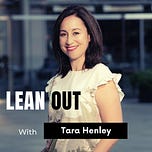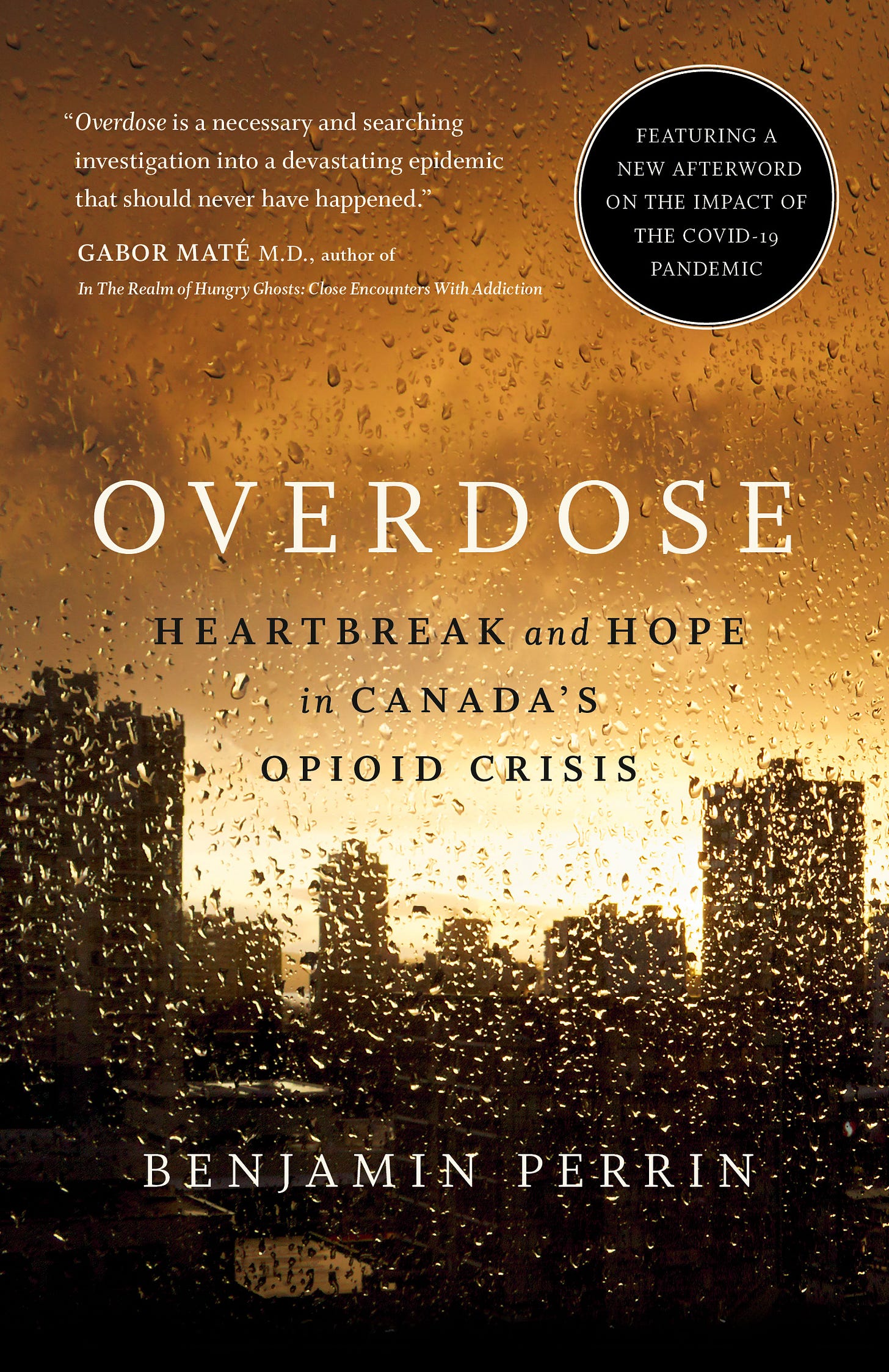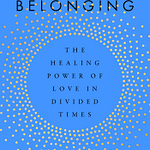As the pandemic winds down, another public health emergency rages — and it is not getting as much attention. I’m speaking, of course, about the opioid crisis. Theresa Tam, Canada’s chief medical officer of health, recently tweeted that the latest data shows that in 2021, 7,560 people died of opioid-related overdose. On average, 21 people died and 17 were hospitalized every day.
My guest on the program today penned an opinion piece in the Vancouver Sun in 2020 warning that our pandemic response could escalate the crisis. And sadly, he has been proven right.
He is a former criminal justice advisor to Prime Minister Stephen Harper who underwent a transformation in his views, becoming a passionate advocate for the decriminalization of drugs, for a safe supply, and above all, for more empathy and compassion for Canadians struggling with addiction.
Benjamin Perrin is a professor at the University of British Columbia’s law school. He’s also the author of Overdose: Heartbreak and Hope in Canada’s Opioid Crisis. The book is a compelling and evidence-based journey through the overdose epidemic, and I’m so happy that Ben Perrin could join me today to talk about it.
Edited highlights from our interview are below. For the full conversation, download the podcast.
On how fentanyl is getting into Canada
TH: You do a great job in this book of outlining why the opioid crisis has been so hard to address. I want to talk about how fentanyl — this toxic drug supply — is getting into the country. What did you learn about how the drug is making its way into Canada, and why it’s so hard to stem that flow?
BP: Fentanyl is a synthetic opioid. What that means is it’s created in the lab. It was created in the late 1950s in Belgium. It was designed for palliative cancer patients, to alleviate pain and suffering. It’s widely used in medical care. I myself, when I went through a procedure a couple years ago, after writing Overdose, asked the anesthesiologist, “What are you giving me?” It was fentanyl. So it’s safe in that setting, because we know the potency, the contents. And I’m being monitored.
Both those [aspects], if they are absent … that’s what leads to people overdosing and dying. So, street drugs are contaminated with varying degrees of fentanyl.
How does it get into Canada? Well, the research that I did for this book at the time was that it was largely coming from China through the mail.
When you talk about potency … The global war on drugs has advanced through the decades — and we’re not talking hundreds of kilograms, we’re talking tonnes of heroin that’s been seized — organized crime did not pack up their bag and go home. This is in the trillions of dollars, likely, the global illicit drug market. If you could ever estimate it. So someone, somewhere, figured you could make this stuff. Why bother trying to smuggle it into countries in packages that are large enough to get detected?
Fentanyl is shipped into Canada in greeting cards. That’s how small it is. That’s how it’s entering Canada. It’s like looking for a needle in a haystack. There’s almost 2 million pieces of small mail that come into Vancouver’s international airport from China every single month. You’re quite frankly wasting your time and resources if you’re trying to crack down on it at the border.
On stigma
TH: I want to get to both safe supply and decriminalization. But first, stigma is an issue that comes up time and time again in this book. And part of the problem with this opioid crisis is it is disproportionately impacting marginalized groups: poor people, Indigenous people, those who’ve been incarcerated. The incarceration piece I was not aware of. Talk to me about why jail puts people at greater risk of overdosing.
BP: People who are recently released from custody are 50 times more likely to overdose and die than someone in the general population … In British Columbia, the coroner in our province has done a fairly substantial amount of work on this issue, and has had several of what are called “death panel reviews” — where they don’t just do autopsies on individuals, but they actually then aggregate and say, “We’re going to look at everyone who died from overdose and identify trends.” One of the top-level findings that they made — which really, again, hasn’t gotten a lot of coverage — is that over 40 percent of people in B.C. who died of illicit drug overdose, during this 1.5 year period they studied, had recently spent time [incarcerated].
Let’s talk about why. The main reason is that in prison, drugs are still widely accessible — but certainly not the same way that they are in the community. And so when someone who has opioid use disorder is incarcerated, they’re using less than they were before and their tolerance rapidly declines. As a result, when they are subsequently released, even if they were only in for 30 days on a short-term sentence, they’re at substantially higher risk of overdosing and dying because of their reduced tolerance.
On trauma
TH: We’re not using the word trauma lightly here. There’s a story that you tell in the book of a person who had been at the murder of their mother and had been left with the body for days before being discovered. This is serious, serious trauma. And we know from the work of Gabor Maté that many of the people on the Downtown Eastside in Vancouver, for example, have experienced huge levels of childhood trauma. Do you think that politicians understand that piece enough?
BP: No, I don’t think they do, at all. In this country, they don’t. And if they do, they don’t care. You know, when we look at things like childhood trauma and intergenerational trauma … When they look at residential school survivors, for instance, they find that you’re looking at around 6 out of 10 of what are called Adverse Childhood Experiences on average ... And if you have over 4, you’re already substantially more likely to use substances. Why? These are painkillers. People are self-medicating.
On safe supply
TH: Let’s spend a moment on safe supply and the NAOMI study. Can you explain what that is and what the results have been?
BP: So there were quite a few people in Vancouver’s Downtown Eastside who had made substantial efforts at getting into treatment and recovery. So the average person in the NAOMI study, I believe, had over 10 attempts at reducing or stopping using. And they had tried all kinds of things. There’s all kinds of different approaches to treatment and recovery that hadn’t worked for them. And most of them were longterm intravenous substance users. I think 15-plus years. So these are people who were going to be using drugs anyway — just to give the context for that.
What the researchers did in these studies — there were two of them, the first was called NAOMI and the other is SALOME — is they provided them with opioids that were of known contents and potency. The individuals would come into a medical clinic and they would use the substances there.
Then researchers tracked things. They looked into things like: Were you still using street drugs? If you were, how much were you spending on them? How were things going in your life? Were you reconnecting with family? Getting jobs? Also, were you overdosing? They tracked the health and criminal justice and social metrics. And they found that across those metrics, people who were provided with that safe supply did better on all those fronts at a statistically significant level.
I talked to judges and criminal defence lawyers, and they told me that they found out later on that they had clients, or accused persons who were appearing before them, who ended up in these studies on the Downtown Eastside. And they didn’t know they were in the study. They just stopped showing up one day.
One criminal defence lawyer I talked to said there was a guy he called a frequent flyer. He said it was literally hundreds of charges that he’d had over the years. One day he stopped hearing from this person. He said he assumed he’d passed away. But then he saw him one day — and he’d ended up in one of these safe supply projects. It really shows us that folks who have opioid use disorder and who are using toxic street drugs, that it’s not the drugs themselves that are the lion’s share of the problem. It’s the criminalization of them.
On the lack of political will to decriminalize possession
TH: The political will is the major issue here. And this goes up to the PMO. Your sources told you about a meeting with Justin Trudeau in which he flat-out said decriminalization is not going to happen, that marijuana was hard enough. You were able to independently verify that statement with another participant in that meeting. What do you think it would take to get the federal Liberals on board?
BP: Well, they had an opportunity in May of 2022 to do that. The NDP brought a private members’ bill forward that would decriminalize simple possession, which is what public health experts have said is needed. What the Canadian Association of Chiefs of Police has said is needed. And growing numbers of organizations. And they chose to not do it. They voted against that legislation. So, this is clearly a political thing.
You have, on one hand, the Conservatives, who are continuing to oppose decriminalization — who actively campaign on criminalizing and demonizing people who use drugs. We see that in the current federal Conservative leadership race. We see that with provincial Conservative politicians, like Jason Kenney in Alberta and Doug Ford in Ontario. And, as a result, the Liberals, even if they were more inclined to decriminalize, they’re afraid … So it is fear and it is politics that is driving policy. Instead of the best available evidence for what would keep people alive during this public health emergency.
This is an edited and condensed transcript. For the full interview, download the podcast.













